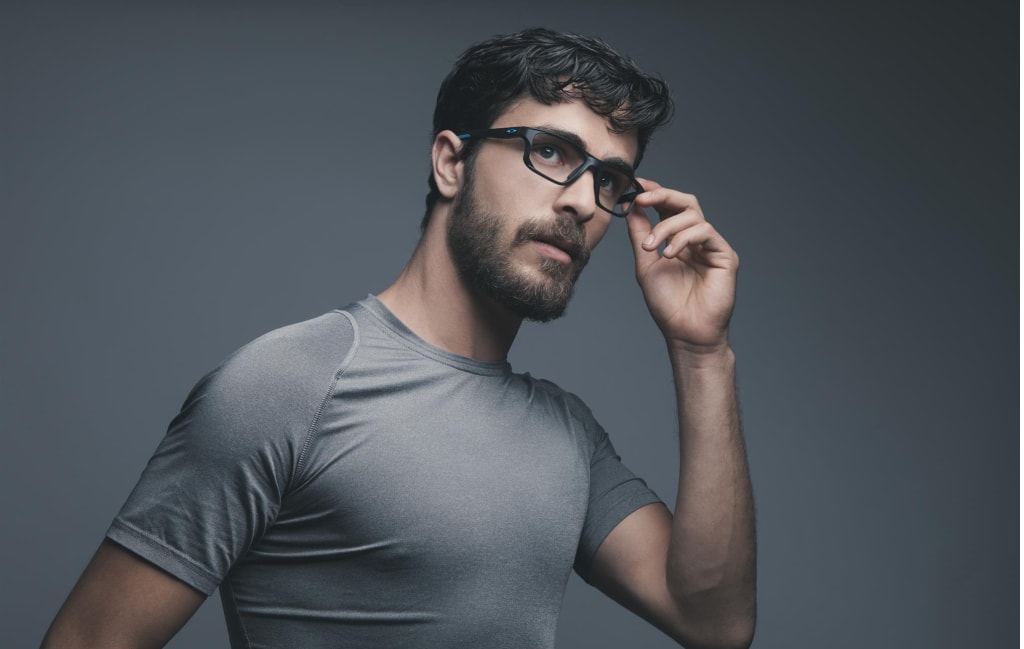Sports Glasses: How to Choose the Perfect Pair for Running, Cycling, Skiing, and More
Updated OCT 23, 2025 • 5 min read

Just like running shoes, or perfect-fitted clothing for slaloming down the slopes, the perfect pair of sports can make all the difference in the world, regardless of your favorite activity. In this guide, we’ll break down the specific eyewear needs for each sport, and hopefully help you find glasses that suit your active lifestyle.
Running Glasses: Lightweight, Secure Fit, and UV Protection
The ideal pair of running glasses should prioritize comfort, stability, and protection against the sun’s harmful UV rays. As a runner, your glasses need to stay secure, especially during high-pace movement in hot, sweaty conditions.
What to look for:
- Lightweight frames: You want glasses that don’t feel heavy or cause discomfort during your run.
- Secure fit: Rubber nose pads and adjustable temples are highly recommended, making sure the glasses sit right and don’t slip as you sweat.
- UV protection: Be it sunglasses with 100% UVA/UVB shielding or sports eyeglasses with 100% UV protection, this is essential for any outdoors runner.
- Anti-fog lenses: Extremely helpful when transitioning between indoor and outdoor environments.
Personal tip: As someone who runs outdoors 4 times a week, I feel most comfortable with wraparound glasses. The wide, curved lenses provide excellent visibility and UV protection. You really feel the impact on longer runs (2.5 miles and up).
Cycling Glasses: Aerodynamics, Ventilation, and Impact Resistance
Cyclists require their glasses to meet a very specific set of demons, whether it’s just weekend joyriding or something more serious. The glasses need to be able to protect you from wind, debris, and the sun, while providing a wide, clear field of vision.
What to look for:
- Aerodynamics: Glasses with ventilation holes or cutouts help reduce drag without compromising comfort or vision.
- Impact-resistant lenses: Falls are something that can happen, so glasses with lenses that meet safety standards such as ANSI Z87.1 are essential. Glasses classified as safety can do the trick as well.
- Polarized lenses: These lenses help reduce glare from reflective surfaces, making them perfect for cycling on sunny days.
As with ski goggles (more on those later) – the compatibility and comfort of the glasses with the helmet you’re wearing will help determine the comfortability factor.
Ski Goggles: Anti-Fog, UV Protection, and Helmet Compatibility
Ski goggles are a vital tool for skiers, having to perform in low temperatures, changing light conditions, and more often than not, some snow on your face.
What to look for:
- Anti-fog: Ski goggles need anti-fog sports glasses tech to avoid your vision getting foggy in the cold weather.
- UV protection: The sun’s rays reflect off snow and ice, so make sure you’re out there with UV protection sports eyewear to deal with harmful rays.
- Helmet compatibility: Your ski goggles should fit seamlessly with your helmet – even more so than for cyclists.
- Lenses for different conditions: Check if the goggles you’re getting come with interchangeable lenses. They’re there to help you adapt and handle changing light, as the sky can turn from clear to overcast pretty quickly.
Swimming Goggles: Watertight, UV Protection, and Comfort
For swimmers, finding the right pair of swimming goggles can dramatically improve performance by providing clear vision underwater while offering protection from chlorine or saltwater.
What to Look For:
- Watertight Seal: Make sure the goggles form a secure seal around your eyes to prevent water from leaking in.
- UV Protection: If you’re swimming outdoors, UV protection is just as important as it is for running or cycling.
- Comfortable Fit: Opt for goggles with soft silicone seals and adjustable straps to ensure comfort during long swimming sessions.
Personal experience tip: I usually swim at an outdoor pool, and switching to goggles with UV protection has made an amazing difference (for the better of course).
Basketball Glasses: Secure Fit and Durability
Indoor and outdoor basketball players need their eyes protected from flying elbows and in general random physical contact that comes with fast-paced play. On top of that, staying on your head helps a lot.
What to look for:
- Durability: Choose eyewear that can handle the intensity of the game. Trivex or polycarbonate lenses are recommended.
- Secure fit: Wraparound frames and adjustable nose pads are great, but goggles that have a flexible strap are even better, preventing slipping during play.
- Clear vision: Obvious, but still worth mentioning. Look for anti-glare coatings to help with visual obstructions.
From experience as someone who has also had a tooth or two chipped in basketball – physical protection comes first. While wraparound frames work great, goggles work best for me, at least with helping feel more secure from an accidental elbow or shoulder.
Golf Glasses: Glare Reduction and Comfort
Few sports demand precise vision for close and far away like golf. Eyewear for the sport should reduce glare and provide comfort during long hours on the course.
What to look for:
- Polarized lenses: Not the first time we’ve mentioned them. Anyone whose picked up a club on a sunny day knows how much glare there is to deal with.
- Comfortable fit: Golf isn’t a “few minutes and you’re done” kind of thing. Long hours mean the glasses should be lightweight, comfortable, and preferably won’t feel like they’re pinching your nose.
UV protection: Long hours in the sun – UV protection is crucial.
More Sports: Volleyball, Fishing, Baseball, and More
Eyewear needs can vary from sport to sport, but some recommended features remain constant across these activities.
- Volleyball: Indoor volleyball players require eyewear that won’t fog up or slip. Lightweight, anti-fog lenses with a secure fit are a must for fast movements and jumping.
- Fishing: Polarized lenses are ideal for fishing, reducing glare off the water to help you see fish clearly.
- Baseball: Ball players benefit from eyewear that offers a wide field of vision, durability, and UV protection. Wraparound frames are the go to option here. It’s not just the cool look, but the sun protection and overall fit is often on a different level to other options.
In general, for sports eyewear, it’s important to look for lenses that offer impact resistance, clear vision, UV protection, and a comfortable, secure fit to keep you performing at your best.
Fitting Sports Glasses: Ensuring Comfort and Stability
Finding the perfect sports glasses often requires trying on various styles to ensure a secure and comfortable fit during activity. Our experienced staff at the GlassesUSA.com stores in Roosevelt Field Mall (New York), The Florida Mall (Orlando, FL), or Natick Mall (Massachusetts) can provide hands-on fitting and advice for your specific sport. Whether you’re looking for prescription sports glasses or durable sports eyewear, trying them on in person ensures the best fit.
Key Fit Considerations:
- Nose Pads: Adjustable nose pads help prevent slipping during vigorous movements.
- Temple Arms: The fit of the temple arms is crucial for stability, especially when you’re active.
- Frame Size: Always check the frame size and ensure it suits your face for comfort.
The Right Pair Will Give You an Edge
Choosing the right sports glasses can make all the difference in your performance and comfort. Whether you’re running, cycling, skiing, or enjoying other outdoor sports, the right eyewear enhances your experience while keeping your eyes protected.
Let your glasses take you even further, whatever the sport. Discover our specialized range of sports glasses online at GlassesUSA.com, or visit our stores at for expert fitting and to see our selection in person.
Published October 23, 2025|Updated October 23, 2025

Jarred Parker
